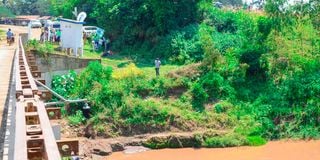New flood forecasting system brings hope to Nyando residents

The hydro meteorological monitoring gadget mounted on a bridge on river Nyando in Ogilo village, Nyando sub county in Kisumu on August 14, 2024.
What you need to know:
- Local leaders have urged residents to protect the flood warning system from vandalism, emphasizing its importance for community safety.
- This project is part of a broader initiative that has been implemented in ten African countries.
Residents of the Nyando River basin in Kisumu County, Kenya, can now breathe a sigh of relief. A state-of-the-art hydrological monitoring system has been installed to provide early warnings of impending floods, reducing the risk of property damage and displacement.
The Nyando River has a history of overflowing its banks during heavy rainfall, causing significant disruption to local communities. In recent years, these floods have become more frequent and intense, leading to widespread suffering.
The most recent incident occurred in May this year when heavy floods affected most parts of the country. As a result, thousands of people living around the Nyando area and its environs were displaced, lost property, livestock was destroyed, and houses were submerged.
To address this pressing and perennial issue, the Nile Basin Initiative, a regional intergovernmental body, implemented a flood warning system and later handed it over to the national government.
The system, which consists of a network of sensors strategically placed along the river, monitors water levels, flow rates, and other hydrological parameters in real time.
When the system detects rising water levels that could pose a threat to communities, it sends out alerts to local authorities and residents through a centralized system for analysis and monitoring. This early warning capability allows for timely evacuation and protective measures, minimising the impact of floods.
For example, residents can move their belongings to higher ground, secure livestock, and prepare for potential power outages. This hydrological system is the sixth in Kenya and the fourth in the Southern region; two are installed in the Northern part of Kenya.
During the handover ceremony, Nyando Community Chairman, Mr Nicholas Otieno said that most people suffer the effects of floods because of late warnings.
“At least this new machine will monitor the flow of water. We shall be able to inform our people in good time so that people can move to higher grounds," Florence Otieno a resident of Nyando recounts how whenever there are floods, they suffer severe hunger once the water subsides.
"We experienced a lot of rainfall early this year which resulted in crop failure and destruction. Farming is our only source of income, once the produce fails, it is difficult for us to educate our children and feed our families," said Mrs Otieno.

Dr Florence Grace Adongo, Nile Basin Initiative Executive Director in an interview during the launch of the hydro meteorological station in Ogilo village, Nyando sub county in Kisumu on August 15, 2024.
Besides offering real-time alerts, the hydrological station can be widely used for meteorological research, disaster prevention and mitigation, and scientific research. Dr Florence Adongo, the Nile Basin Initiative Executive Director explained that the machine works by putting together data gathered from satellite images and the internet.
It captures data after every 10 minutes and relays it to monitoring offices in Kisumu, Nairobi and Entebbe. “The technical people can keep track of the behaviour of water if it is rising and alert residents to get away from the risky areas instead of depending on the technical people coming to the ground with their tapes to measure the levels of water, ” she said.
Local leaders have urged residents to protect the flood warning system from vandalism, emphasizing its importance for community safety. This project is part of a broader initiative that has been implemented in ten African countries.
The Nile Basin Initiative was established 25 years ago in African countries. Some of the member countries include Burundi, DR Congo, Egypt, Ethiopia, Eritrea, South Sudan, Rwanda, Tanzania, Kenya and Uganda.



